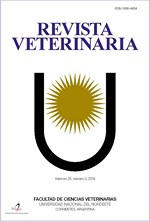Histochemical analyses of muscle injury induced by venom from Argentine Bothrops alternatus (víbora de la cruz)
DOI:
https://doi.org/10.30972/vet.1721945Palavras-chave:
Bothrops alternatus, muscle injury, histochemical analyses.Resumo
Histochemical methods were used to study necrosis of skeletal muscle fibers induced by Bothrops alternatus snake venom from Argentina. Rats with a body weight between 220–270 g, were used. Animals received an i.m. venom injection (800 μg) in the gastrocnemius. To determine creatinphosphokinase activity (CPK), blood samples were taken from the tail 60 min, 3, 6, 12 and 24 h after the envenoming. About 24 h later, rats received chloral hydrate anesthesia for histological analysis with Hematoxilin–Eosin (H–E) stain, and histochemical studies such as lipid peroxidation (Schiff’s reaction), and calcium precipitation (alizarin red stain). Results showed an increment in plasma CPK level, with its major peak at 3 h. Histochemical analyses revealed an intense destruction of muscular fibers as a consequence of a significant lipid peroxidation and calcium precipitation as well. Histochemical methods can be considered as a valuable tool in applied research regarding toxicological problems such as snake venom intoxication. It can be concluded that B. alternatus snake venom leads to a lipid peroxidation accompanied by citoplasmatic calcium precipitation. In addition, it was demonstrated that H–E stain made on frozen cuts (histochemical technique) is effective to evidence a panoramic tissular view of muscular lesion caused by B. alternatus venom, with the advantage of demanding a shorter execution lapse (few hours) in relationship to classic H–E histological technique, which requires several days of procesing.Downloads
Downloads
Publicado
Como Citar
Edição
Seção
Licença
Política de acceso abierto
Esta revista proporciona un acceso abierto inmediato a su contenido, basado en el principio de que ofrecer al público un acceso libre a las investigaciones ayuda a un mayor intercambio global de conocimiento. La publicación por parte de terceros será autorizada por Revista Veterinaria toda vez que se la reconozca debidamente y en forma explícita como lugar de publicación del original.
Esta obra está bajo una licencia de Creative Commons Reconocimiento-NoComercial 4.0 Internacional (CC BY-NC 4.0)










.jpg)
.jpg)



